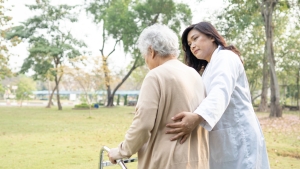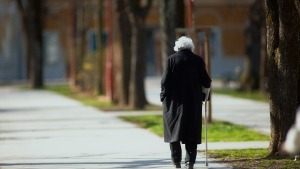Elisabeth de Courrèges, occupational therapist, is currently on a mission with the Œuvre d’Orient in a pediatric palliative care unit in Armenia. Summoning the memory of an internship carried out in a palliative care unit in Lille, she evokes the delicate question of the spiritual accompaniment of people at the end of life.
Can faith move mountains? In any case, she can move beds. From a bedroom to an elevator, then from the elevator to a garden, then from the garden to a chapel. Led with energy by two nuns in blue and white habit, the large wheeled bed, its passenger all smiles and its immaculate white sheets make their way through the midst of the multiple trolleys for care, meals and cleaning, bypassing the stored wheelchairs and busy orderlies.
All that’s missing is a broom wagon informing you: “Attention, exceptional convoy” one might think. Yet since the beginning of my internship in a palliative care service in Lille, this fuss has been nothing special. It is even quite usual in this palliative care unit attached to a religious community. If the care is provided by professionals from various disciplines, the sisters interfere discreetly and simply in the times and free spaces that each day offers them. To meet the patients, to introduce oneself, to discuss life and the “after” or to pray.
So what do nuns come to do in this care of the disease or the end of life? What do these comings and goings to the chapel mean in an already busy care and treatment schedule? What is the use of externalizing so much this spiritual dimension so intimate and so interior of life?
The very principle and essence of palliative care: supporting the person in all their dimensions.
There is no proselytizing or opportunistic recuperation here. There is simply a reminder of what, since their creation, constitutes the very principle and essence of palliative care: support for the person in all their dimensions.
At the same time that we care for a body, a psyche and relationships, we accompany an individual with an inner life to which we must give the same attention. Only then will we be able to identify with a little more precision the mystery of the person we are accompanying.
There is of course the art and the way of doing things: first of all being the designated interlocutor, whether officially (religious, volunteer, chaplain) or unofficially, when the patient brings up the subject in front of you quite knowingly , and that you are summoned to it. Then you have to be ready. Without imposing, without imposing. Hear his questions, reflections, rebellions and consider them.
Spirituality, an essential dimension of human life
Because human life is expressed through a state of health, a place in society… but also through a spirituality. We would be wrong to deny it, bury it or rebuff it. Because it influences the body, relationships and the psyche. “A cry of spiritual distress is still a cry that reminds us of how much the person is still alive,” a volunteer in a palliative care unit once told me.
Now a graduate and volunteering in Armenia, I discover that the subject is not taboo here: in the team that I joined, we heal and we pray. Each in their own way, with a religion, a faith or just an inner life. This allows sick children to express their spiritual life to themselves as well.
And as if to complete this accompaniment in its entirety, the nuns who house this medical unit for abandoned children went to pray on November 2, the day of the dead, at the tomb of each of their little proteges. Then I remembered the words of Jesus, expressed in a cry at the end of his life, as He handed over his body, his soul and his Spirit together: “It is finished”.


End of life: also supporting the patient’s spiritual dimension

